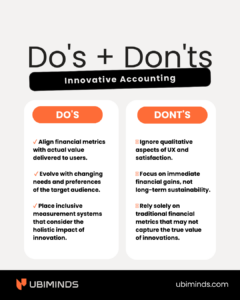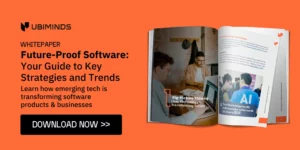Explore the power of Innovative Accounting for software startups and discover the importance of building a sustainable business from day one by creating value, acquiring customers, and generating revenue. Get inspired by recommended sources and learn actionable steps to implement these strategies immediately.
Why We Should Redefine Success in Software Startups
Software Companies commonly define success as financial performance alone. However, a paradigm shift is underway, ushering in an era where startups are redefining their measurement of success. Enter Innovative Accounting. The a game-changing approach that goes beyond traditional financial metrics and delves into tracking the true impact of innovation and learning.
What Is Innovative Accounting?
Innovative Accounting, as proposed by Eric Ries, is a revolutionary approach that transcends traditional financial metrics in measuring the success of software startups. It is about redefining success by prioritizing long-term value creation over short-term financial gains.
3 Principles of Innovative Accounting
-
Long-Term Value Focus: Shift from short-term financial metrics to long-term value creation for sustained business growth.
-
Continuous Learning: Embrace a culture of constant learning and experimentation to adapt to market dynamics.
-
User-Centric Metrics: Prioritize metrics that reflect user engagement, satisfaction, and the genuine impact of innovations.

Innovative Accounting isn’t just about the numbers—it’s about building sustainable value from day one. (Ubiminds)
What Innovative Accounting Is:
- A strategic approach that aligns financial metrics with the actual value delivered to users.
- A dynamic method that evolves with the changing needs and preferences of the target audience.
- An inclusive measurement system that considers the holistic impact of innovation on both customers and the business.
What Innovative Accounting Isn’t:
- Merely focusing on immediate financial gains without considering long-term sustainability.
- Relying solely on traditional financial metrics that may not capture the true value of innovations.
- Ignoring the qualitative aspects of user experiences and satisfaction.
Tracking the Impact of Innovation
Instead of solely focusing on financial performance, this approach measures the outcomes of your experiments, pivots, and adaptations. By tracking how your innovations resonate with users, you gain insights that guide your future decisions. This shift in perspective emphasizes a continuous cycle of improvement, where learning and adaptation become the heartbeat of your business strategy.
Comparative Analysis: Traditional Metrics vs. Innovative Accounting Metrics
| Metrics | Traditional Metrics | Innovative Accounting |
|---|---|---|
| Focus | Financial performance alone | Impact of innovation and learning |
| Measurement | Monetary gains and losses | Experiment outcomes, learning metrics |
| Purpose | Short-term financial results | Continuous improvement and long-term impact |
| Feedback Source | Historical financial data | Real-time insights from user interactions |
| Decision Guidance | Historical performance trends | Future-oriented, guided by continuous learning |
How to Apply Innovative Accounting to Day-to-Day Operations:
- Experiment Outcomes: Evaluate the success of experiments beyond monetary gains. Understand how user engagement, feedback, and adaptation contribute to your startup’s growth.
- Learning Metrics: Introduce metrics focused on learning and adaptation. Measure the insights gained from user behavior, market responses, and the effectiveness of strategic pivots.
- User-Centric Impact: Shift from solely revenue-centric goals to user-centric impact. Prioritize features and enhancements that resonate with users, ensuring sustained value creation.
If you’re C-level, David Binetti’s talk on Using Innovation Accounting for Valuation and Risk Management is definitely worth your time:
3 Ways to Apply Innovative Accounting to Macroprocesses within Software Companies
In practice, this means looking at macroprocesses within software companies and navigating the do’s and don’ts of this transformative journey. Applicable examples include:
1. Agile Development
Implement agile methodologies to facilitate iterative development and quick adaptation to changing requirements.
| Traditional Approach | Innovative Accounting Approach |
|---|---|
| Metrics Emphasized: Project timelines Budget adherence Resource utilization. | Metrics to Prioritize: User Story Completion Rate: Measure how effectively user stories are delivered, emphasizing value over speed. Customer Satisfaction Scores: Capture user satisfaction to gauge the impact of delivered features. Adaptation Speed: Assess how quickly the team adapts to changing requirements. |
| Pitfalls: Often leads to a focus on meeting deadlines at the expense of delivering value. | Outcome: Encourages a shift from output-focused development to outcome-driven results. Aligns the development process with the creation of long-term value for users. |
2. User Feedback Loops
Establish efficient feedback loops to capture user insights and integrate them into the development process.
| Traditional Approach | Innovative Accounting Approach |
|---|---|
| Metrics Emphasized: Volume of bug reports and Response time to user issues. | Metrics to Prioritize: User Satisfaction Surveys: Gather qualitative feedback on user experiences and satisfaction. Feature Adoption Rates: Evaluate how quickly users adopt and benefit from new features. Net Promoter Score (NPS): Measure users' likelihood to recommend the product. |
| Pitfalls: May not provide a comprehensive view of user satisfaction or the success of new features. | Outcome: Enhances the understanding of user needs, preferences, and the real impact of implemented features. Enables data-driven decisions based on the holistic user experience. |
3. Experimentation Frameworks
Develop frameworks for controlled experiments to test hypotheses and gather data for informed decisions.
| Traditional Approach | Innovative Accounting Approach |
|---|---|
| Metrics Emphasized: Success or failure of an experiment based on predefined KPIs. | Metrics to Prioritize: Learning Velocity: Measure how quickly insights from experiments are integrated into the development process. Innovation Impact Index: Evaluate the overall impact of experiments on the product's innovation level. User Retention Post-Experiment: Assess whether new features introduced through experiments contribute to user retention. |
| Pitfalls: Limited focus on the broader impact of experiments on user satisfaction and long-term value. | Outcome: Encourages a culture of continuous learning and adaptation based on experiment results. Aligns experiments with the creation of sustainable value and user-centric outcomes. |
How to Keep the Team Focused on Learning and Adaptation
So how do you move beyond vanity metrics and build a truly sustainable software company loved by its customers? Well, if there’s anything startups have taught us, it’s that a culture of continuous learning and adaptation is sure to reap benefits.
3 Do’s to Foster Innovation
- 1. Encourage Experimentation: Cultivate a culture where team members feel empowered to experiment and learn from failures.
- 2. Regular Retrospectives: Conduct regular retrospectives to reflect on past projects, identify areas for improvement, and implement changes.
- 3. Cross-Functional Collaboration: Foster collaboration between different teams, allowing for a holistic view of challenges and innovative solutions.
3 Don’ts that Damage Your Team’s Adaptability
- 1. Fear of Failure: Avoid a culture that punishes failure. Instead, treat failures as opportunities for valuable insights and improvements.
- 2. Static Processes: Resist the temptation to stick to static processes. Embrace flexibility to adapt to evolving market conditions.
- 3. Isolated Decision-Making: Discourage decision-making in silos. Involve relevant stakeholders to ensure a well-rounded perspective on challenges and opportunities.
Seeking Inspiration: Recommended Resources for Software Startups
Delve into thought-provoking blogs, books, and podcasts that illuminate the path to value-driven success.
- Blogs like Seth’s Blog by Seth Godin and First Round Review offer actionable insights from industry leaders.
- Books such as Lean Analytics by Alistair Croll and Value Proposition Design by Alexander Osterwalder provide in-depth strategies for creating, measuring, and optimizing value. (Our Booklist can be inspirational.)
- Podcasts like StartUp Podcast and The Lean Startup for firsthand accounts of startups navigating the value-focused landscape. (Sidenote: you might also enjoy this curated list of what to listen to.)
Putting It into Motion: Actionable Steps for Immediate Impact
Now, let’s turn inspiration into action by fostering collaboration between your departments:
Step 1: Identifying Key Value Propositions
Define your startup’s core value propositions collaboratively across departments. What unique problems are you solving for your target audience?
- Involve product development, marketing, and software development teams to ensure a holistic understanding.
- Craft your product with these value propositions at its core, aligning business objectives with customer needs.
Step 2: Crafting Customer-Centric Experiences
Ensure seamless collaboration between marketing and product development to create customer-centric experiences. Focus on customer acquisition strategies that resonate with your value propositions.
Leverage email marketing, social media engagement, and partnerships to connect with your ideal customers. Consider customers’ journeys and pain points in every interaction, aiming for a conversion rate that reflects a genuine connection.
Step 3: Revenue Generation Strategies from the Start
Bring together business owners, marketing experts, and financial teams to develop revenue models aligned with the value you’re delivering. Whether it’s subscription-based, freemium, or usage-based pricing, ensure your pricing strategy reflects the value your customers receive. Consider factors like customer acquisition costs (CAC), total revenue, and the long-run impact on your customer base.
Innovative Accounting and a focus on sustainable business practices are reshaping the landscape of software startups. By measuring the impact of innovation and prioritizing value creation collaboratively across departments, you’re equipped to build a startup that thrives on meaningful growth.
Ubiminds can provide you with the manpower and network to put these strategies into action, fostering collaboration across your teams, and watch your startup flourish in the new era of value-driven success.

International Marketing Leader, specialized in tech. Proud to have built marketing and business generation structures for some of the fastest-growing SaaS companies on both sides of the Atlantic (UK, DACH, Iberia, LatAm, and NorthAm). Big fan of motherhood, world music, marketing, and backpacking. A little bit nerdy too!






